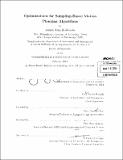| dc.contributor.advisor | Emilio Frazzoli. | en_US |
| dc.contributor.author | Bialkowski, Joshua John | en_US |
| dc.contributor.other | Massachusetts Institute of Technology. Department of Aeronautics and Astronautics. | en_US |
| dc.date.accessioned | 2014-05-23T19:35:26Z | |
| dc.date.available | 2014-05-23T19:35:26Z | |
| dc.date.copyright | 2014 | en_US |
| dc.date.issued | 2014 | en_US |
| dc.identifier.uri | http://hdl.handle.net/1721.1/87475 | |
| dc.description | Thesis: Ph. D., Massachusetts Institute of Technology, Department of Aeronautics and Astronautics, 2014. | en_US |
| dc.description | Cataloged from PDF version of thesis. | en_US |
| dc.description | Includes bibliographical references (pages 141-150). | en_US |
| dc.description.abstract | Sampling-basedalgorithms solve the motion planning problem by successively solving several separate suproblems of reduced complexity. As a result, the efficiency of the sampling-based algorithm depends on the complexity of each of the algorithms used to solve the individual subproblems, namely the procedures GenerateSample, FindNearest, LocalPlan, CollisionFree, and AddToGraph. However, it is often the case that these subproblems are quite related, working on common components of the problem definition. Therefore, distinct algorithms and segregated data structures for solving these subproblems might be costing sampling-based algorithms more time than necessary. The thesis of this dissertation is the following: By taking advantage of the fact that these subproblems are solved repeatedly with similar inputs, and the relationships between data structures used to solve the subproblems, we may significantly reduce the practical complexity of sampling-based motion planning algorithms. Moreover, this reuse of information from components can be used to find a middle ground between exact motion planning algorithms which find an explicit representation ofthe collision-free space,and sampling-based algorithms which find no representation of the collision-free space, except for the zeromeasure paths between connected nodes in the roadmap. | en_US |
| dc.description.statementofresponsibility | by Joshua John Bialkowski. | en_US |
| dc.format.extent | 150 pages | en_US |
| dc.language.iso | eng | en_US |
| dc.publisher | Massachusetts Institute of Technology | en_US |
| dc.rights | M.I.T. theses are protected by copyright. They may be viewed from this source for any purpose, but reproduction or distribution in any format is prohibited without written permission. See provided URL for inquiries about permission. | en_US |
| dc.rights.uri | http://dspace.mit.edu/handle/1721.1/7582 | en_US |
| dc.subject | Aeronautics and Astronautics. | en_US |
| dc.title | Optimizations for sampling-based motion planning algorithms | en_US |
| dc.type | Thesis | en_US |
| dc.description.degree | Ph. D. | en_US |
| dc.contributor.department | Massachusetts Institute of Technology. Department of Aeronautics and Astronautics | |
| dc.identifier.oclc | 879662814 | en_US |
